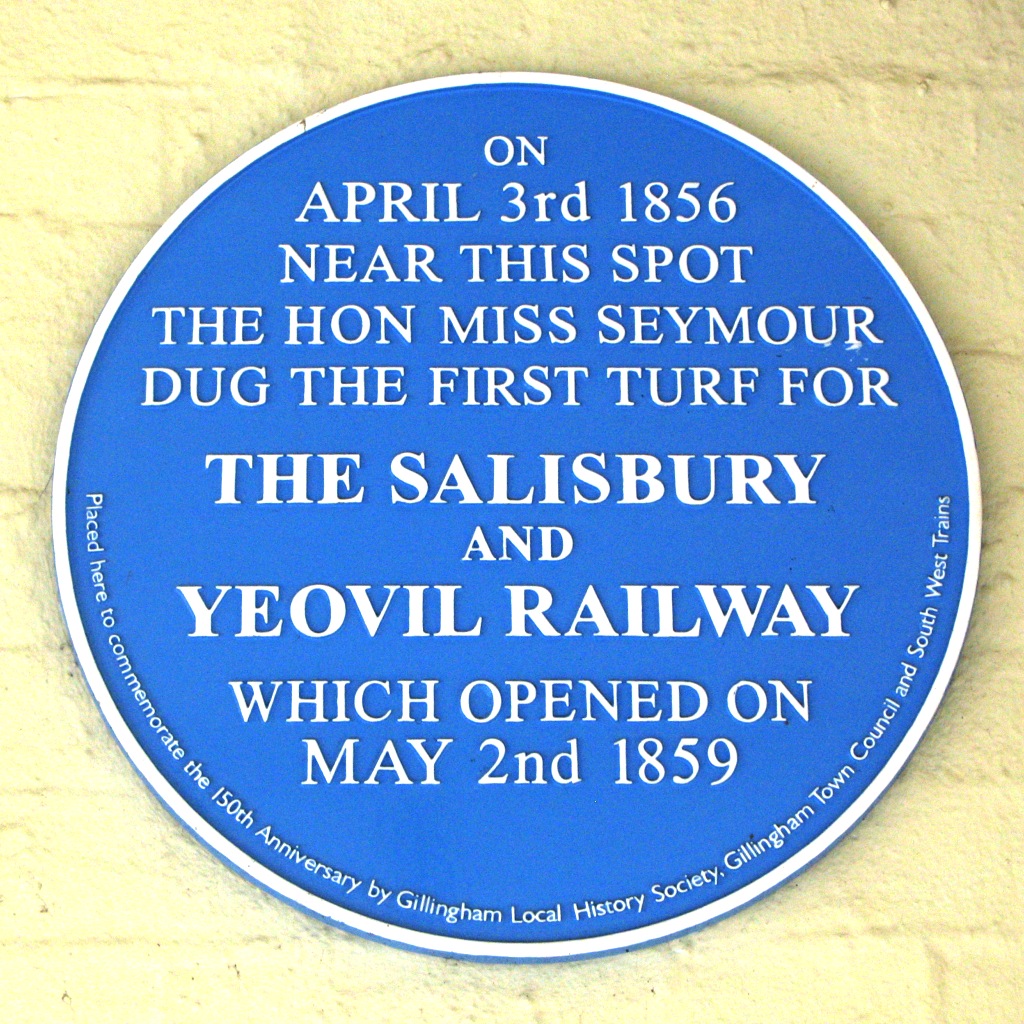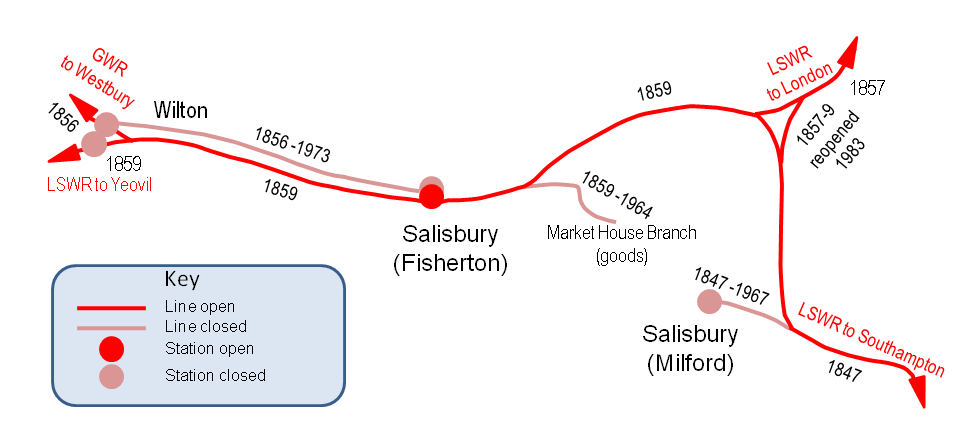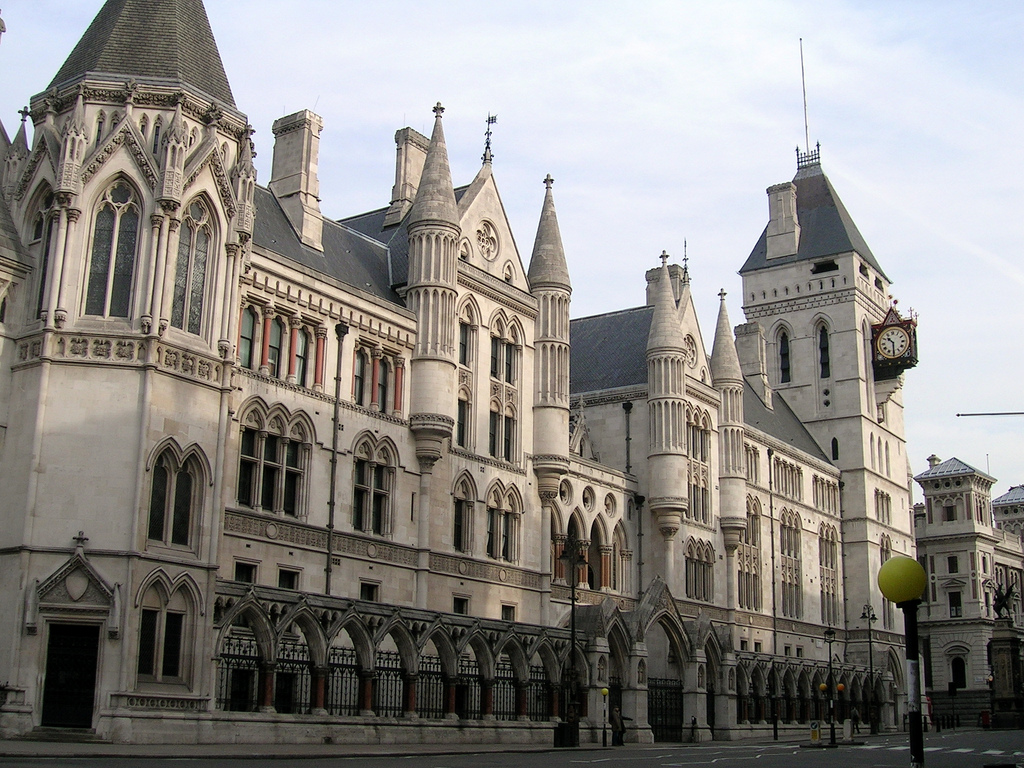|
Salisbury Branch Line (Great Western Railway)
The Salisbury branch line of the Great Western Railway from to Salisbury in Wiltshire, England, was completed in 1856. Most of the smaller stations were closed in 1955 but the line remains in use as part of the Wessex Main Line. History Wilts and Somerset Railway In 1844 the Great Western Railway (GWR) and the London and South Western Railway (LSWR) were engaged in a struggle to secure territory, known as the gauge war: the GWR lines were broad gauge and the LSWR were standard gauge, sometimes called "narrow gauge" for contrast. When the LSWR proposed a new line from Basingstoke to Newbury and Swindon, the GWR sought to fend it off with their own proposal, a branch line from their main line at Thingley Junction, west of Chippenham, to Salisbury. In this period the government's policy was that any general area could only support one railway line, and a commission appointed by the Board of Trade would appraise rival proposals and determine which should be permitted. In this cas ... [...More Info...] [...Related Items...] OR: [Wikipedia] [Google] [Baidu] |
Great Western Railway
The Great Western Railway (GWR) was a British railway company that linked London with the southwest, west and West Midlands of England and most of Wales. It was founded in 1833, received its enabling Act of Parliament on 31 August 1835 and ran its first trains in 1838 with the initial route completed between London and Bristol in 1841. It was engineered by Isambard Kingdom Brunel, who chose a broad gauge of —later slightly widened to —but, from 1854, a series of amalgamations saw it also operate standard-gauge trains; the last broad-gauge services were operated in 1892. The GWR was the only company to keep its identity through the Railways Act 1921, which amalgamated it with the remaining independent railways within its territory, and it was finally merged at the end of 1947 when it was nationalised and became the Western Region of British Railways. The GWR was called by some "God's Wonderful Railway" and by others the "Great Way Round" but it was famed as the "Holiday ... [...More Info...] [...Related Items...] OR: [Wikipedia] [Google] [Baidu] |
Sherborne
Sherborne is a market town and civil parish in north west Dorset, in South West England. It is sited on the River Yeo, on the edge of the Blackmore Vale, east of Yeovil. The parish includes the hamlets of Nether Coombe and Lower Clatcombe. The A30 road, which connects London to Penzance, runs through the town. In the 2011 census the population of Sherborne parish and the two electoral wards was 9,523. 28.7% of the population is aged 65 or older. Sherborne's historic buildings include Sherborne Abbey, its manor house, independent schools, and two castles: the ruins of a 12th-century fortified palace and the 16th-century mansion known as Sherborne Castle built by Sir Walter Raleigh. Much of the old town, including the abbey and many medieval and Georgian buildings, is built from distinctive ochre-coloured ham stone. The town is served by Sherborne railway station. Toponymy The town was named ''scir burne'' by the Saxon inhabitants, a name meaning "clear stream", after a broo ... [...More Info...] [...Related Items...] OR: [Wikipedia] [Google] [Baidu] |
Salisbury And Yeovil Railway
The Salisbury and Yeovil Railway linked Salisbury (Wiltshire), Gillingham (Dorset) and Yeovil (Somerset) in England. Opened in stages in 1859 and 1860, it formed a bridge route between the main London and South Western Railway (LSWR) network and its lines in Devon and Cornwall. Its trains were operated by the LSWR and it was sold to that company in 1878. Apart from a short section in Yeovil it remains open and carries the London Waterloo to Exeter service of South Western Railway. Despite being founded after the "Railway Mania" of the 1840s, it proved to be one of the most profitable railways in the United Kingdom. This was in part due to carrying all LSWR trains to the south west, and in part due to the very good terms agreed for the LSWR to operate the trains. When the company finally sold out to the LSWR in 1878, it held out for a price which saw the shareholders receive more than the face value of their shares. History The LSWR was completed to Southampton in 1840 and a ... [...More Info...] [...Related Items...] OR: [Wikipedia] [Google] [Baidu] |
Salisbury Railway Station
Salisbury railway station serves the city of Salisbury in Wiltshire, England. It is from on the West of England line to . This is crossed by the Wessex Main Line from Bristol Temple Meads to Southampton Central. The station is operated and served by South Western Railway (SWR), and is also served by Great Western Railway (GWR). History Three railway station sites have been used in Salisbury, owned by the London and South Western Railway (LSWR) from 1847 and the Great Western Railway (GWR) from 1856, as well as two further stations at Wilton, west. London and South Western Railway The LSWR opened their Milford station on the east side of the city on 1 March 1847, with the opening of their branch line from Eastleigh, near Southampton, to passenger traffic. This was the city's only railway until 30 June 1856, when the GWR opened the Salisbury branch from Westbury. On 1 May 1857, the LSWR opened the extended main line from London and Andover, at first to the Milford stat ... [...More Info...] [...Related Items...] OR: [Wikipedia] [Google] [Baidu] |
Milford, Wiltshire
Laverstock is a village and civil parish on the north-east and east outskirts of Salisbury in the ceremonial county of Wiltshire, England. The parish is shaped like a figure 7 and incorporates Ford hamlet, the eastern half of the former manor of Milford, the area near the ancient settlement of Old Sarum, and part of the Hampton Park district on the edge of Salisbury. Laverstock, the parish's main settlement, lies on the east bank of the River Bourne and is approximately east of Salisbury city centre, due south of Swindon and west-southwest of London. History Flint mines and signs of barrows have been discovered on Burrough's Hill, indicating settlement back to Neolithic time. There is also evidence of settlement during the Iron and Bronze Age. A Roman cemetery and settlement has been found on Cocky's Hill. Laverstock has two entries in the Domesday Book which indicate the settlement was then owned by Wilton Abbey with some parts owned by officers of the king. Milford Mill B ... [...More Info...] [...Related Items...] OR: [Wikipedia] [Google] [Baidu] |
Milford Railway Station
Milford railway station is a railway station serving the village of Milford in the English county of Surrey. It is a stop on the Portsmouth Direct Line, from . The station has two side platforms flanking a pair of tracks, with step free access to both platforms. The platforms are linked by a publicly accessible footbridge and an adjoining level crossing controlled by safety barriers. There is a ticket office, staffed during weekday mornings only, on the northbound platform, and ticket machines are available at all times the station is open. The station car park has 136 spaces. The station has the same name as the fictional station in the film ''Brief Encounter'' (1945) starring Trevor Howard and Celia Johnson, although the scenes were filmed at Carnforth station in Lancashire. Services All services at Milford are operated by South Western Railway using and EMUs Emus may refer to: * Emu The emu () (''Dromaius novaehollandiae'') is the second-tallest living b ... [...More Info...] [...Related Items...] OR: [Wikipedia] [Google] [Baidu] |
Telegraph
Telegraphy is the long-distance transmission of messages where the sender uses symbolic codes, known to the recipient, rather than a physical exchange of an object bearing the message. Thus flag semaphore is a method of telegraphy, whereas pigeon post is not. Ancient signalling systems, although sometimes quite extensive and sophisticated as in China, were generally not capable of transmitting arbitrary text messages. Possible messages were fixed and predetermined and such systems are thus not true telegraphs. The earliest true telegraph put into widespread use was the optical telegraph of Claude Chappe, invented in the late 18th century. The system was used extensively in France, and European nations occupied by France, during the Napoleonic era. The electric telegraph started to replace the optical telegraph in the mid-19th century. It was first taken up in Britain in the form of the Cooke and Wheatstone telegraph, initially used mostly as an aid to railway signalling. Th ... [...More Info...] [...Related Items...] OR: [Wikipedia] [Google] [Baidu] |
Wilton, Wiltshire
Wilton is a town and civil parish in Wiltshire (of which it was once the county town), England, with a rich heritage dating back to the Anglo-Saxons. Carpets have been manufactured at Wilton since the 18th century. Today it is overshadowed by its larger neighbour, Salisbury, but retains a range of shops and attractions including Wilton House and a large Romanesque parish church. The confluence of the rivers Wylye and Nadder is at Wilton. History The history of Wilton dates back to the Anglo-Saxons in the 8th century, and by the late 9th century it was the capital of ''Wiltunscire'', a shire of the Kingdom of Wessex. It remained the administrative centre of Wiltshire until the 11th century. Wilton was of significant importance to the church, with the founding of Wilton Abbey in 771 amongst other establishments. In 871 Alfred the Great fought and lost an important battle here against the Danish armies, leaving him in retreat for several years. Despite further attacks, Wilt ... [...More Info...] [...Related Items...] OR: [Wikipedia] [Google] [Baidu] |
Wylye
Wylye () is a village and civil parish on the River Wylye in Wiltshire, England. The village is about northwest of Salisbury and a similar distance southeast of Warminster. The parish extends north and south of the river, and includes the hamlet of Deptford. Today Deptford is at the junction of two primary roads, the A303 (London to the southwest) and the A36 (Southampton to Bristol). In 1934 half of Fisherton parish was added to Wylye, including the small village of Fisherton Delamere. History A collection of Bronze Age jewellery found near the village by metal detectorists in 2012, known as the Wylye Hoard, is held by Salisbury Museum. Bilbury Rings, on the southern slope of the valley, is an Iron Age hillfort. Nearby is a prehistoric field system. A Roman road from Winchester to the Mendips passes through the southern edge of the parish. The boundaries of Wyle manor, and possibly also of Deptford manor, were defined in the 10th century. Domesday Book in 1086 recorded ... [...More Info...] [...Related Items...] OR: [Wikipedia] [Google] [Baidu] |
Bathampton
Bathampton () is a village and civil parish east of Bath, England on the south bank of the River Avon. The parish has a population of 1,603. The Kennet and Avon Canal passes through the village and a toll bridge links Bathampton to Batheaston on the north bank of the canal. History Bathampton Camp is a univallate Iron Age hill fort situated approximately east from the village. The site was excavated in 1904–05 and in 1952–54. Results found human and animal remains, pottery and flint flakes. The parish was part of the hundred of Hampton. The village used to be served by Bathampton railway station, but it was closed following the destructive Beeching cuts. Plasticine was manufactured in the village between 1900 and 1983 by a company founded by William Harbutt, who also lived in Bathampton. Governance The parish council has responsibility for some local issues, including setting an annual precept (local rate) to cover the council's operating costs and producing annua ... [...More Info...] [...Related Items...] OR: [Wikipedia] [Google] [Baidu] |
Queen's Bench Division Of The High Court Of Justice Of England And Wales
The High Court of Justice in London, known properly as His Majesty's High Court of Justice in England, together with the Court of Appeal and the Crown Court, are the Senior Courts of England and Wales. Its name is abbreviated as EWHC (England and Wales High Court) for legal citation purposes. The High Court deals at first instance with all high value and high importance civil law (non- criminal) cases; it also has a supervisory jurisdiction over all subordinate courts and tribunals, with a few statutory exceptions, though there are debates as to whether these exceptions are effective. The High Court consists of three divisions: the King's Bench Division, the Chancery Division and the Family Division. Their jurisdictions overlap in some cases, and cases started in one division may be transferred by court order to another where appropriate. The differences of procedure and practice between divisions are partly historical, derived from the separate courts which were merged in ... [...More Info...] [...Related Items...] OR: [Wikipedia] [Google] [Baidu] |
Mandamus
(; ) is a judicial remedy in the form of an order from a court to any government, subordinate court, corporation, or public authority, to do (or forbear from doing) some specific act which that body is obliged under law to do (or refrain from doing), and which is in the nature of public duty, and in certain cases one of a statutory duty. It cannot be issued to compel an authority to do something against statutory provision. For example, it cannot be used to force a lower court to take a specific action on applications that have been made, but if the court refuses to rule one way or the other then a mandamus can be used to order the court to rule on the applications. Mandamus may be a command to do an administrative action or not to take a particular action, and it is supplemented by legal rights. In the American legal system it must be a judicially enforceable and legally protected right before one suffering a grievance can ask for a mandamus. A person can be said to be aggrie ... [...More Info...] [...Related Items...] OR: [Wikipedia] [Google] [Baidu] |









